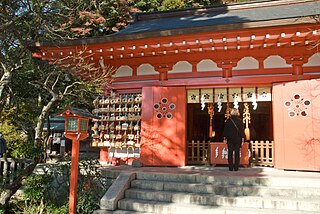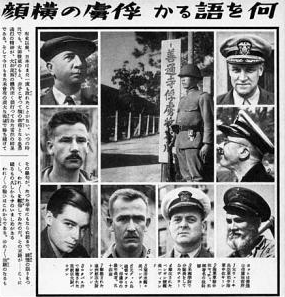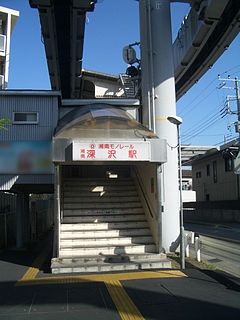 W
WAmanawa Shinmei Shrine was founded in 710 and is the oldest Shinto shrine in Kamakura. It is dedicated to the sun goddess Amaterasu. According to the ancient document History of Amanawa-ji Shinmei-gū kept by the shrine, the founder of the shrine is famous priest Gyōki; a powerful and rich man named Tokitada Someya supported the construction.
 W
WEgara Tenjin Shrine , is a Shinto shrine in Kamakura. Having been founded according to legend by an unknown priest in 1104, it is one of the few extant religious institutions in the area to predate the advent of Minamoto no Yoritomo, who arrived here in 1181. Like all other Tenjin shrines in Japan, it enshrines the spirit of famous scholar and politician Sugawara no Michizane under the name Tenjin. For this reason, the kami is believed to be a protector of intellectual pursuits.
 W
WFujimichō Station is a monorail train station on the Shōnan Monorail Enoshima Line located in Kamakura, Kanagawa Prefecture, Japan. It is located 0.9 kilometers from the northern terminus of the Shōnan Monorail Enoshima Line at Ōfuna Station.
 W
WGlory Academy, Kamakura, is a private Catholic junior and senior high school for boys, located in
 W
WHatakeyama Rokurō Shigeyasu (畠山六郎重保) was a Kamakura period warrior who fell victim of political intrigue in 1205. The grave under a tabu no ki tree near the Yuigahama end of Wakamiya Ōji Avenue in Kamakura, Kanagawa Prefecture, Japan and next to Tsurugaoka Hachiman-gū's first torii is traditionally supposed to be his. It is an Important Cultural Property and a famous example of hōkyōintō. Famous for the quality of its manufacture, the hōkyōintō' is 3.45 m tall and is made of andesite.
 W
WThe Kamakura Museum of Literature is a small museum in Kamakura, Kanagawa, Japan, that contains material about writers who have lived, died, or were active in the city of Kamakura itself. The museum displays personal effects, manuscripts, first editions, and documents owned by well over a hundred writers of Japanese literature, including Natsume Sōseki and Kawabata Yasunari, as well as film director Yasujirō Ozu. The villa that hosts the museum, its large garden and its rose garden are also of great interest.
 W
WThe Kamakura Museum of National Treasures or Kamakura Museum or Kamakura National Treasure House is a museum located on the grounds of Tsurugaoka Hachiman-gū in Yukinoshita, Kamakura, Kanagawa Prefecture, Japan. The museum houses around 4800 objects from the Kamakura region including sculptures, paintings and industrial art objects. Most of these works originate from the Kamakura and Muromachi periods, spanning from the 12th to the 16th century. Some of the items were produced in China and imported to Japan.
 W
WKamakura Station is a railway station on the Yokosuka Line in Kamakura, Kanagawa, Japan, operated by East Japan Railway Company.
 W
WKamakura Women's University is a private women's college in Kamakura, Kanagawa Prefecture, Japan. The school specializes in home economics and child care.
 W
WKataseyama Station is a monorail train station on the Shōnan Monorail Enoshima Line in Kamakura, Kanagawa Prefecture, Japan. It is 5.5 kilometers from the northern terminus of the Shōnan Monorail Enoshima Line at Ōfuna Station. It is an elevated station with single side platform serving bidirectional traffic, and is unattended.
 W
WKita-Kamakura Station is a railway station on the Yokosuka Line in Kamakura, Kanagawa, Japan, operated by East Japan Railway Company.
 W
WMoto Hachiman (元八幡) is a small but very old and historically important Shinto shrine in Kamakura, Kanagawa Pref., Japan.
 W
WNishi-Kamakura Station is a monorail train station on the Shōnan Monorail Enoshima Line located in Kamakura, Kanagawa Prefecture, Japan. It is located 4.7 kilometers from the northern terminus of the Shōnan Monorail Enoshima Line at Ōfuna Station.
 W
WThe Ōfuna Camp was an Imperial Japanese Navy installation located in Kamakura, outside Yokohama, Japan during World War II, where high-value enlisted and officers, particularly pilots and submariner prisoners of war were incarcerated and interrogated by Japanese naval intelligence. Richard O'Kane, Louis Zamperini and Gregory Boyington were among the prisoners held at Ōfuna.
 W
WSasuke Inari Shrine is a Shinto shrine in Kamakura and the site of the Hidden Village of Kamakura. It is located very near the Zeniarai Benzaiten Ugafuku Shrine.
 W
WShōnan-Fukasawa Station is a monorail train station on the Shōnan Monorail Enoshima Line located in Kamakura, Kanagawa Prefecture, Japan. It is located 2.6 kilometers from the northern terminus of the Shōnan Monorail Enoshima Line at Ōfuna Station.
 W
WShōnan-Machiya Station is a monorail train station on the Shōnan Monorail Enoshima Line located in Kamakura, Kanagawa Prefecture, Japan. It is located 2.0 kilometers from the northern terminus of the Shōnan Monorail Enoshima Line at Ōfuna Station.
 W
WThe tomb of Minamoto no Yoritomo (源頼朝の墓) is a monument in Kamakura, Kanagawa, Japan, located some hundred meters north of the site where the palace called Ōkura Bakufu, seat of Minamoto no Yoritomo's government, once stood. Although there is no evidence his remains are actually there, it is commonly assumed to be the resting place of Minamoto no Yoritomo, founder and first shōgun of the Kamakura shogunate. The cenotaph consists of a 186 cm gorintō surrounded by a stone tamagaki, and was built during the Edo period (1603–1868), far after the shōgun's death in 1199. In the course of history, the site's prestige has attracted other structures, so that now it is occupied by the Site of the Hokke-dō,, Shirahata Shrine , and the black stone stele commemorating the Hokke-dō and the mass suicide of the Miura clan. A couple of hundred meters further to the east lie the yagura of the Miura clan, the twin tombs of Oe no Hiromoto and of his son Mōri Suemitsu, and the grave of Yoritomo's illegitimate son Shimazu Tadahisa. The grave of Yoritomo and the ruins of the Hokke-dō are national Historic Sites.
 W
WTsurugaoka Hachimangū (鶴岡八幡宮) is the most important Shinto shrine in the city of Kamakura, Kanagawa Prefecture, Japan. The shrine is a cultural center of the city of Kamakura and serves as the venue of many of its most important festivals with two museums.
 W
WYagura are artificial caves used during the Middle Ages in Kamakura, Kanagawa Prefecture, Japan, as tombs and cenotaphs. It is likely that they were used only as tombs in the beginning, and were later used as cenotaphs. The dead are mostly from the samurai class, but the names of priests and artisans have also been found. These tombs are extremely numerous in the hills surrounding Kamakura, and estimates of their number range from 1,500 to over 5,000. The total number will remain unknown, as many have been destroyed and others may not yet have been found.
 W
WZeniarai Benzaiten Ugafuku Shrine , popularly known simply as Zeniarai Benten, is a Shinto shrine in Kamakura, Kanagawa, Kanagawa prefecture, Japan. In spite of its small size, it is the second most popular spot in Kamakura, Kanagawa prefecture after Tsurugaoka Hachiman-gū. Zeniarai Benzaiten is popular among tourists because the waters of a spring in its cave are said to be able to multiply the money washed in it. The object of worship is a syncretic kami which fuses a traditional spirit called Ugafukujin (宇賀福神) with the Buddhist goddess of Indian origin Sarasvati, known in Japanese as Benzaiten. The shrine is one of the minority in Japan which still shows the fusion of native religious beliefs and foreign Buddhism which was normal before the Meiji restoration. Zeniarai Benzaiten used to be an external massha of Ōgigayatsu's Yazaka Daijin (八坂大神), but became independent in 1970 under its present name.